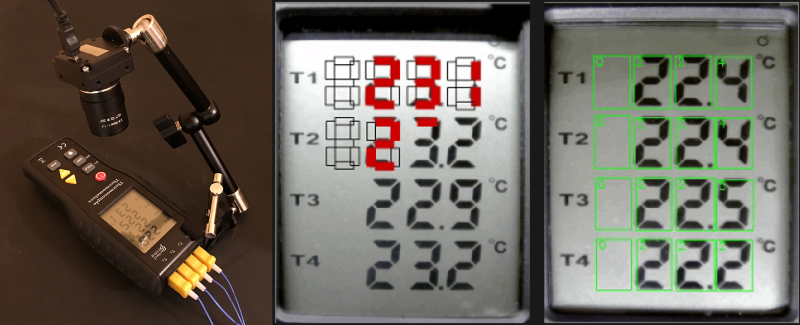As much as we’d like to have the right tools for the right job all of the time, sometimes our parts drawers have other things in mind. After all, what’s better than buying a new tool than building one yourself from things you had lying around? That’s at least what [Saulius] must have been thinking when he needed a thermometer with a digital output, but only had a dumb, but feature-rich, thermometer on hand.
Luckily, [Saulius] had a webcam lying around as well as an old thermometer, and since the thermometer had a LCD display it was relatively straightforward to get the camera to recognize the digits in the thermometer’s display. This isn’t any old thermometer, either. It’s a four-channel thermometer with good resolution and a number of other useful features (with an obvious lack of communications abilities), so it’s not something that he could just overlook.
Once the camera was mounted to an arm and pointed at the thermometer’s screen, an algorithm running on a computer detects polygons and reports its information into a CSV file. This process is made simpler by the fact that LCD screens like this are very predictable. From there, the data is imported into LibreOffice and various charts and graphs can be made.
Although perhaps not the most elegant of hacks, sometimes you have to work with the supplies that are on hand at the time. Sometimes the tools you need are too expensive, politically dangerous, or too impractical to obtain. To that end [Saulius]’s hack is a great example of what hacks are possible with the right mindset.
















or just use a 2 buck Chinese arduino
“an algorithm running on a computer” – WOW, really that’s how this works?
It’s actually a couple of hundred lines of Python with OpenCV. And by coincidence the site is a business and sells the camera used.
Ok, so it’s not actually all that “lucky” that he had this webcam “lying around”. More accurate words might be “inevitable” and “in stock”.
Does this guy just sell components because people kept asking for kits of the stuff he built? That can happen. Although it can turn out badly pretty easily, when fans turn into customers, and their favourite website becomes a business. Big Clive sells a few kits, but only cheap, simple stuff, because people ask him to when he does projects (and can tear himself away from scrapping pound-shop lights and discovering, “yep, it’s an LED and a battery”).
Clive’s only doing that to help people, he doesn’t make any large amount of money through it. I wouldn’t object to a HAD article giving a guy like that a hand. OTOH an actual company that has to compete with everyone else, selling stuff everyone else does, I’d expect a good reason for a journalist to give them free press.
Is he just drumming up business? It’s hard to tell. If it’s just some small guy, who built a following, and sells stuff to help people learn and get into the hobby, I can’t really complain about this article seemingly being a flat advert for a business. Incidentally, even if Bryan Cockfield didn’t know that this guy actually has a business selling those parts, he should have found out before he wrote the article. Even if Bryan and HAD made no money from this advertising, it’s still advertising. Just daft enough to do it for free.
Anyway… so he didn’t luckily have a $120 (!!!!!) USB camera just lying around. In that case it’s a pretty weird way of doing this project. Would’ve been better to see if there was anywhere you could poke around inside the thermometer’s case, even if it just means reading the LCD display’s driving signals directly and working out their values that way. Or sticking little photoreflector modules over each segment.
That’s all assuming you really really needed that particular thermometer to be monitored electronically. For the $120 camera, and however much the computer that’s monitoring it costs, there’s surely something cheaper and more direct.
Finally, thanks!
I was looking for this kind of data logger for about 20 years now, but since it was needed only sparsely, I was too lazy to start writing one, and always look for hardware workarounds instead.
Because nowadays webcams and Linux boards cost peanuts, this kind of tool can be used to log almost anything, without altering the metering device, e.g. water/gas/electricity remote reading and logging.
Very useful, worth a try.
>as well as an old thermometer
no, brand new $40 chinesium rebrander Perfect-Prime TC41 bought specially for the occasion
instead could of gotten two $40 MASTECH (actual real company specializing in metering equipment) MS6514 dual K type temp data loggers with USB buildin.
feels more like a self wound than a hack ;)
I lied, its $26 https://perfect-prime.com/collections/k-type-thermocouple/products/tc41-perfectprime , now it makes some sense
but only some ;) since I learned (from HaD, thank you) about $2 MAX6675 chinesium clones, 4x $2.5 for MAX6675 modules + 4x $1 K-type probes + $3 MCU board (arduino, smt32 blue pill) and you can have your very own proper 4 channel temp logger with USB, SD logging and hookers.
Saw the same meter on ebay for ridiculously low prices and had the same idea :D
But unlike me, this guy actually managed to make a working concept.
I would love a teardown of this meter, is it a highly optimized COB on bare pcb? or MAX6675 + 74HC4051 + cheapest STC 8051 clone they could find + dedicated LCD?
When you said “old thermometer”, us geezers thought Mercury!
I’m sure you can use OpenCV with a Mercury Thermometer too (if you can find one).
LOL, I bet it’s a lot easier!
Hadvertising
A teardown might have revealed a serial stream somewhere on the board that the data could have been harvested from. These meters often have the capability but it’s not made public.